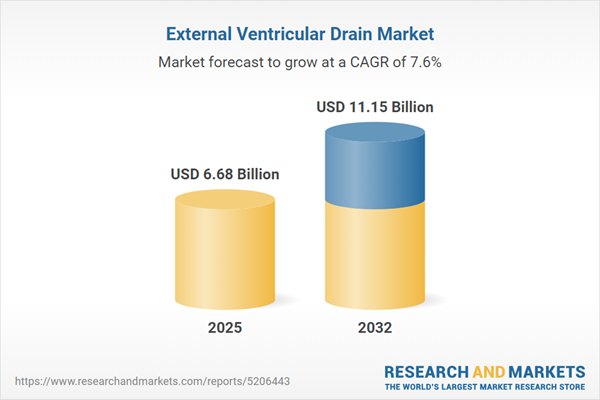Speak directly to the analyst to clarify any post sales queries you may have.
Senior healthcare executives face an increasingly nuanced external ventricular drain (EVD) market shaped by technological innovation, heightened regulatory scrutiny, and the imperative to maintain clinical safety in neurological care. Navigating these challenges demands focused strategies to manage procurement risks, streamline workflows, and fulfill elevated expectations from care teams and stakeholders in both acute and longer-term treatment settings.
Market Snapshot: External Ventricular Drain Market Trends and Outlook
The external ventricular drain market is on a strong growth trajectory, expanding from USD 6.20 billion in 2024 to USD 6.68 billion in 2025 at a CAGR of 7.61%, with projections suggesting the market could reach USD 11.15 billion by 2032.
Growth is driven by updated neurological care protocols, stricter infection control standards, and continuing device innovation. Providers in both hospitals and ambulatory settings increasingly prioritize EVD solutions that can deliver reliable performance and adapt to the evolving needs of patient populations. Accelerated adoption rates reflect the demand for workflow-friendly technologies and consistent device reliability that supports clinical decision-making and patient safety across varied care scenarios.Scope & Segmentation of the External Ventricular Drain Market
This report delivers targeted insight to guide executive decisions on technology acquisition, procurement strategies, and deployment within neurocritical care and associated specialties. Understanding the operational and regional factors affecting EVD adoption supports smarter resource allocation and long-term resilience. Each market segment shapes the organizational approach to selection, integration, and investment planning.
- End User: Hospitals, neurosurgical centers, and ambulatory surgical facilities each face unique workflow and safety challenges influencing how they evaluate and integrate EVD systems.
- Portability: Non-portable EVDs help maintain stable monitoring in ICU and step-down units, while portable models increase flexibility and facilitate fast response across departments.
- Product Types: Core catheter systems and accessories such as clamps, transducer kits, and collection bags are configured for both routine use and complex neurological cases, supporting essential patient safety and infection control.
- Distribution Channels: Direct sourcing from manufacturers, distributor partnerships, and digital procurement platforms all influence supply chain efficiency, enabling tailored sourcing of high-specialty neurological devices.
- Clinical Applications: EVDs address diverse neurological conditions, including hydrocephalus, acute intracranial hemorrhage, and traumatic brain injury, each requiring care-specific technical configurations.
- Geographical Regions: Regulatory frameworks, healthcare system maturity, and rates of technology adoption vary across the Americas, Europe, Middle East & Africa, and Asia-Pacific, necessitating regionalized strategies for procurement and deployment.
A clear understanding of these market segments enables executive teams to time investments effectively, align EVD integration with institutional objectives, and respond to local and global best practices.
Key Takeaways for Senior Decision-Makers
- Deploying advanced EVD solutions helps organizations comply with evolving clinical safety standards and quality measures in neurology departments.
- Sensor-enhanced devices and effective infection prevention features promote operational reliability, supporting care teams managing complex neurological needs.
- Available options for portable and digitally integrated EVD systems increase flexibility, enhancing care delivery in both high-acuity and resource-limited settings.
- Monitoring regulatory shifts supports improved supplier collaboration and reduces the risk of interruptions in access to specialized neurological equipment.
- Adopting modular technology platforms and open procurement methods enables scalable implementation while protecting supply chain continuity.
Tariff Impact: Navigating U.S. Trade and Supply Chain Pressures
Significant adjustments in U.S. tariff regulations affecting vital inputs such as polymers, engineered metals, and sensor technologies are impacting both costs and supply chain dynamics for the EVD market. To mitigate exposure to price and supply volatility, decision-makers are turning to diversified sourcing models, nearshoring manufacturing operations, and utilizing transparent procurement platforms. Ongoing collaboration between manufacturers and providers ensures regulatory compliance and helps maintain steady access to critical neurological device solutions despite external trade pressures.
Methodology & Data Sources
Findings in this report are based on direct interviews with industry leaders, clinician-based surveys, reviews of regulatory documentation, and systematic literature evaluations. Each insight is validated using publicly available data sets, providing reliable, actionable analysis for executives shaping strategic decisions in the external ventricular drain market.
Why This Report Matters
- Equips healthcare leadership with authoritative, data-driven insights to guide technology investment and procurement for neurological device portfolios.
- Supports efficient purchasing with current market benchmarks and reference standards that facilitate compliance in changing regulatory settings.
- Combines clinical expertise with robust market analysis, empowering organizations to make agile, informed decisions in technology adoption and clinical operations.
Conclusion
This report enables healthcare organizations to strengthen their neurological care strategies, bolster procurement resilience, and ensure the effective deployment of EVD technologies as they respond to current and future clinical needs.
Additional Product Information:
- Purchase of this report includes 1 year online access with quarterly updates.
- This report can be updated on request. Please contact our Customer Experience team using the Ask a Question widget on our website.
Table of Contents
3. Executive Summary
4. Market Overview
7. Cumulative Impact of Artificial Intelligence 2025
Companies Mentioned
The companies profiled in this External Ventricular Drain market report include:- Integra LifeSciences Corporation
- Medtronic plc
- B. Braun Melsungen AG
- Stryker Corporation
- Johnson & Johnson
- Becton, Dickinson and Company
- Sophysa SA
- Raumedic AG
- CSF Dynamics, Inc.
- Miethke GmbH & Co. KG
Table Information
| Report Attribute | Details |
|---|---|
| No. of Pages | 197 |
| Published | October 2025 |
| Forecast Period | 2025 - 2032 |
| Estimated Market Value ( USD | $ 6.68 Billion |
| Forecasted Market Value ( USD | $ 11.15 Billion |
| Compound Annual Growth Rate | 7.6% |
| Regions Covered | Global |
| No. of Companies Mentioned | 11 |









